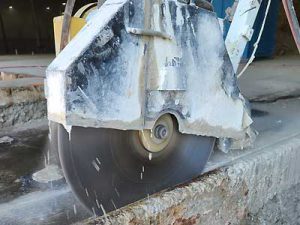
Let’s look at the differences between dry and wet concrete cutting to help you understand which method might be best for your project. After all, both dry cutting and wet cutting can be done using a diamond saw blade, and both techniques result in quality cuts. So, which is the best cutting method for your situation?
Dry Cutting
The user uses a handheld saw with low horsepower and sturdier diamond blades when dry cutting. These dry-cutting blades often have segment welds to help prevent overheating. Since this process creates substantial heat, dry cutting should only be used intermittently over short periods.
Benefits of Dry Cutting
Diamond-cutting blades in a dry cutter make clean cuts without the risk of damaging the concrete or injuring the operator. The technique is best for small-scale applications or job sites you want to keep as clean as possible. It’s also used for menial tasks or urgent cutting needs where you need to complete a fast job.
Since they are handheld machines, dry cutters are also more comfortable to work with for users. In addition, dry cutters give users more control over how deep or shallow to cut.
Disadvantages of Dry Cutting
The most serious disadvantage when using dry cutters is the amount of dust it creates. This dust can be hazardous to the health of the users and others in the vicinity. In addition, it requires using a vacuum or extractor to capture the dust.
Another disadvantage of a dry cutter is that it is typically only used to cut straight lines. Operating a dry cutter also means more downtime so the operator can ensure sufficient airflow.
Wet Cutting
Wet cutting describes using a walk-behind saw that sprays water on the concrete to cool the blades as they cut. Wet-cutting saws are typically used for large-scale projects since they can run more extended periods without worrying about creating too much heat.
Advantages of Wet Cutting
Wet cutting results in precise cuts, and the blades are less likely to overheat since the water keeps the machine cool. Since you don’t have to wait for the blade to cool, you can get more done over the same period of time. Also, the water eliminates dust creation, and this technique usually results in a smoother finish.
Disadvantages of Wet Cutting
Wet cutting causes the job site to look messy. Additionally, wet cutters are more aggressive than dry cutters, so the blades are more likely to damage materials. Finally, wet cutters have a shorter lifespan.
Let KC Coring and Cutting Analyze Your Job Site
Need help determining whether your job calls for wet cutting or dry cutting? You don’t have to know. Contact KC Coring and Cutting, and we will analyze the situation to find the perfect solution.
KC Coring and Cutting has been serving the KC Metro area for more than four decades. Check out the powerful testimonials on our website or call 816-523-2015 to schedule a consultation.
